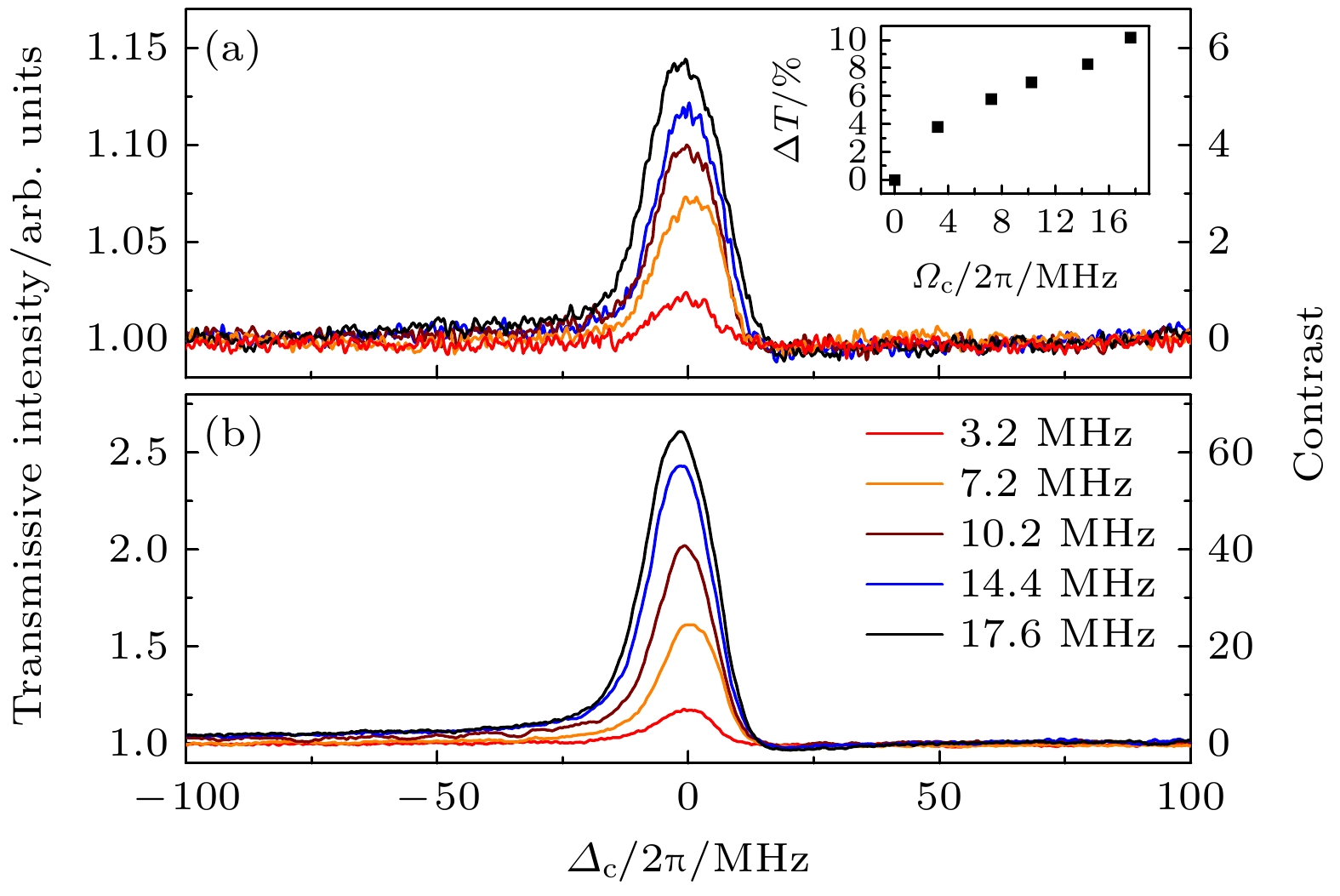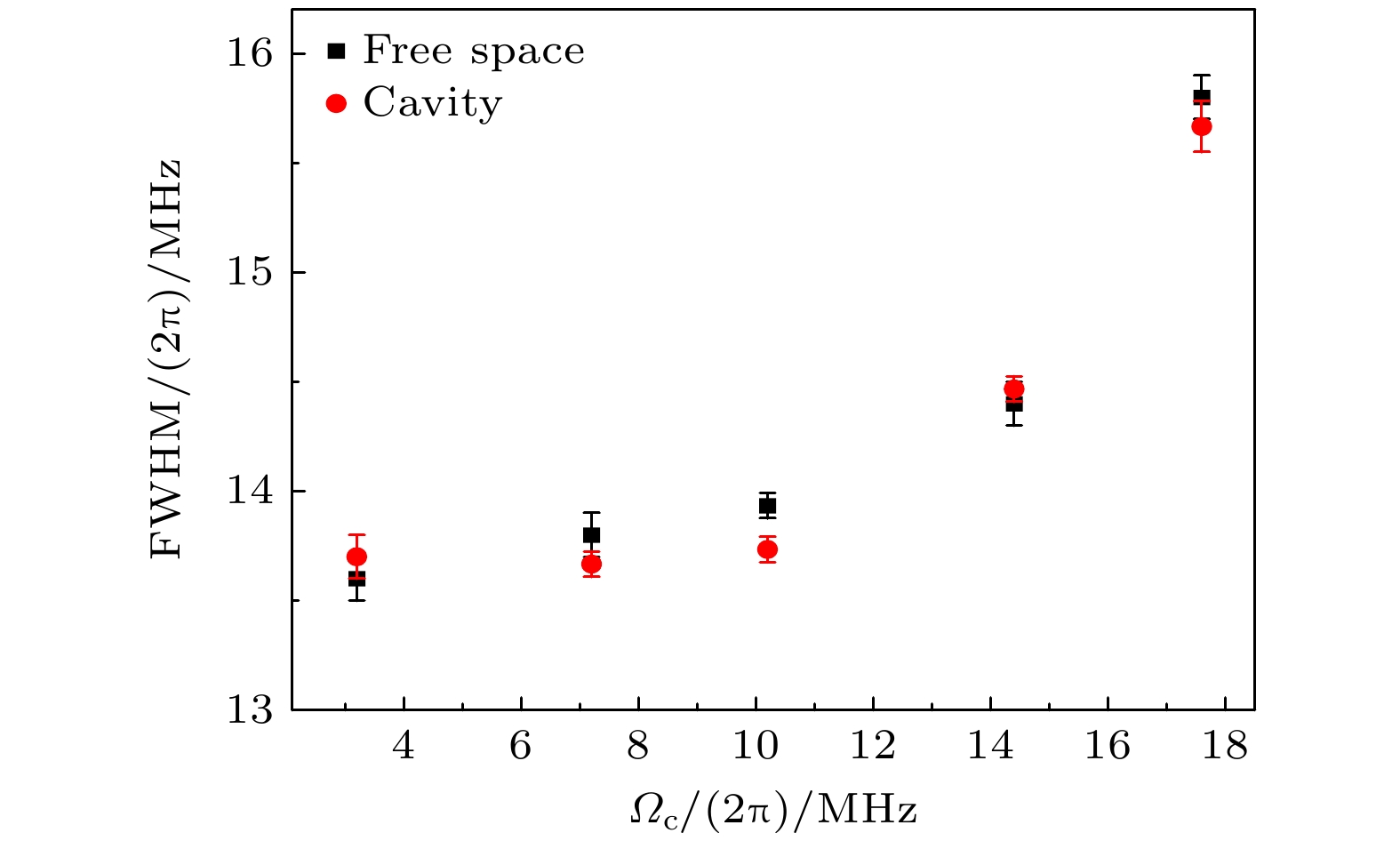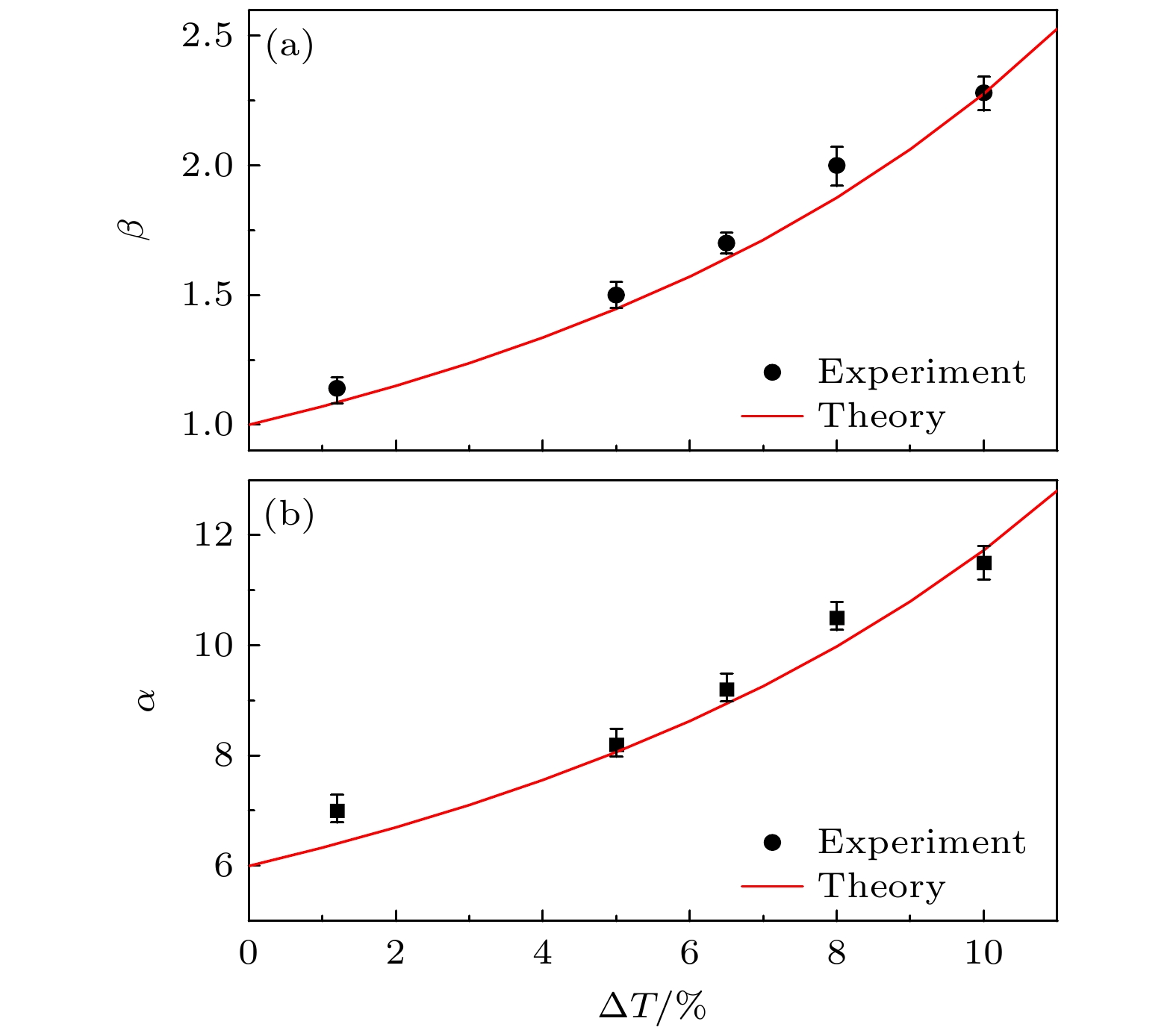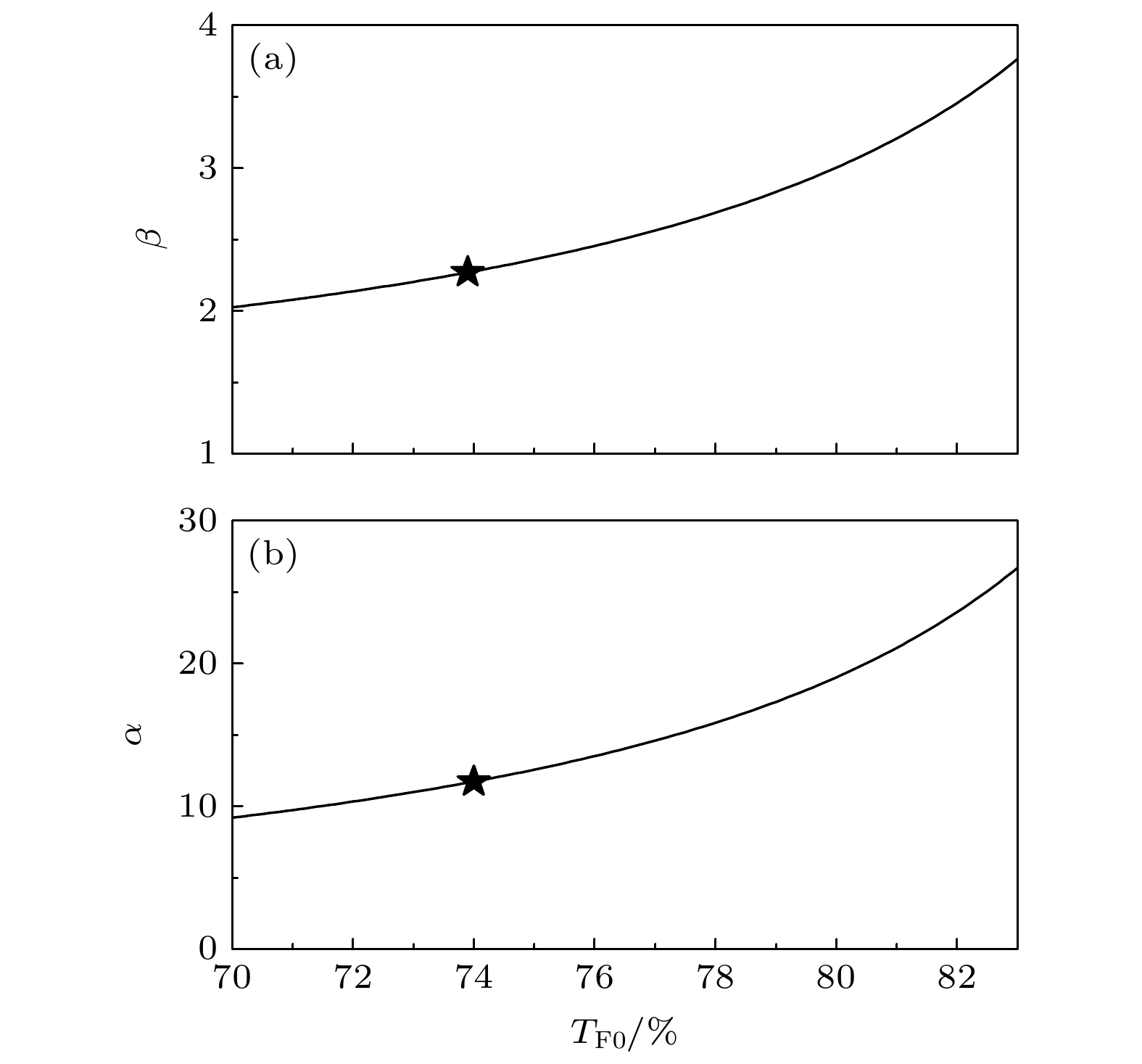-
高精度里德伯原子光谱在研究里德伯原子间的相互作用、里德伯能级结构、电磁场的精密测量等方面具有重要的应用价值, 里德伯原子光谱对比度、信噪比的提高和线宽的压窄是获得高灵敏测量的基础. 本文通过理论和实验研究了腔增强的里德伯原子光谱, 与自由空间的光谱相比实现了在光谱线宽不变情况下11.5倍的光谱对比度和信噪比的提高. 其原因是在双光子共振处产生的电磁诱导透明和光泵浦效应会导致腔内原子对探测光吸收的减弱, 提高了光学腔的阻抗匹配效率, 从而使进入腔内的光强增大, 因此提高了里德伯原子光谱的对比度和信噪比, 提高的倍数取决于探测光穿过原子的透射率. 预期通过优化铯原子温度, 光谱的对比度和信噪比能够提高23倍. 本工作为提高里德伯原子光谱的对比度和基于里德伯原子的精密测量灵敏度提供了参考.High-precision spectra of Rydberg atoms are of significance in studying the interaction between Rydberg atoms, the energy level structure of Rydberg atom, and the precision measurement of the electromagnetic field. To enhance the measurement sensitivity, it is necessary to achieve the high contrast, high signal-to-noise ratio, and narrow linewidth of the spectra of the Rydberg atoms. In this work, the cavity-enhanced spectra of Rydberg atoms are studied theoretically and experimentally. Comparing with the free-space spectra of Rydberg atoms, the contrast and the signal-to-noise ratio are enhanced by 11.5 times, with the linewidth unchanged. Under the condition of two-photon resonance, both the electro-magnetically induced transparency and the double-resonance optical-pumping process can suppress the absorption of the probe laser, thereby improving the impedance matching of the cavity. As the intracavity probe laser intensity turns stronger, the contrast and signal-to-noise ratio can be improved further, and the improvement depends on the transmission of the probe laser through the atom vapor. It is expected that the contrast and signal-to-noise ratio can be improved by a factor of 23 through optimizing the temperature of the cesium atom vapor. This work provides an important reference for improving the contrast of the spectra of Rydberg atoms and the sensitivity of Rydberg-based precision measurements.
-
Keywords:
- Rydberg atom /
- optical resonant cavity /
- Cs atomic vapor cell /
- impedance matching
[1] Adams C S, Pritchard J D, Shaffer J P 2020 J. Phys. B: At. Mol. Opt Phys. 53 012002
 Google Scholar
Google Scholar
[2] Saffman M, Walker T G, Mølmer K 2010 Rev. Mod. Phys. 82 2313
 Google Scholar
Google Scholar
[3] Sedlacek J A, Schwettmann A, Kubler H, Low R, Pfau T, Shaffer J P 2012 Nat. Phys. 8 819
 Google Scholar
Google Scholar
[4] Zhang L J, Bao S X, Zhang H, Raithel G, Zhao J M, Xiao L T, Jia S T 2018 Opt. Express 26 29931
 Google Scholar
Google Scholar
[5] Bason M G, Tanasittikosol M T, Sargsyan A, Mohapatra A K, Sarkisyan D, Potvliege R M, Adams C S 2010 New J. Phys. 12 065015
 Google Scholar
Google Scholar
[6] Barredo D, Kubler H, Daschner R, Löw R, Pfau T 2013 Phys. Rev. Lett. 110 123002
 Google Scholar
Google Scholar
[7] Jing M Y, Hu Y, Ma J, Zhang H, Zhang L J, Xiao L T, Jia S T 2020 Nat. Phys. 16 911
 Google Scholar
Google Scholar
[8] 裴栋梁, 何军, 王杰英, 王家超, 王军民 2017 物理学报 66 193701
 Google Scholar
Google Scholar
Pei D L, He J, Wang J Y, Wang J C, Wang J M 2017 Acta Phys. Sin. 66 193701
 Google Scholar
Google Scholar
[9] Bao S X, Zhang H, Zhou J, Zhang L J, Zhao J M, Xiao L T, Jia S T 2016 Phys. Rev. A 94 043822
 Google Scholar
Google Scholar
[10] Wang X, He J, Bai J D, Wang J M 2020 Appl. Sci. 10 5646
 Google Scholar
Google Scholar
[11] Mohapatra A K, Jackson T R, Adams C S 2007 Phys. Rev. Lett. 98 113003
 Google Scholar
Google Scholar
[12] Zhao J M, Zhu X B, Zhang L J, Feng Z G, Li CY, Jia S T 2009 Opt. Express 17 15821
 Google Scholar
Google Scholar
[13] Petrosyan D, Otterbach J, Fleischhauer M 2011 Phys. Rev. Lett. 107 213601
 Google Scholar
Google Scholar
[14] Yang B D, Jing G, Zhang T C, Wang J M 2011 Phys. Rev. A 83 013818
 Google Scholar
Google Scholar
[15] Wu B H, Chuang Y W, Chen Y H, Yu J C, Chang M S, Yu I A 2017 Sci. Rep. 7 9726
 Google Scholar
Google Scholar
[16] Su H J, Liou J Y, Lin I C, Chen Y H 2022 Opt. Express 30 1499
 Google Scholar
Google Scholar
[17] Peng Y D, Wang J L, Yang A H, Jia Z M, Li D H, Chen B 2018 J. Opt. Soc. Am. B 35 2272
 Google Scholar
Google Scholar
[18] Li S H, Yuan J P, Wang L R, Xiao L T, Jia S T 2022 Fhys. 10 846687
[19] 王雅君, 王俊萍, 张文慧, 李瑞鑫, 田龙, 郑耀辉 2021 物理学报 70 204202
 Google Scholar
Google Scholar
Wang Y J, Wang J P, Zhang W H, Li R X, Tian L, Zheng Y H 2021 Acta Phys. Sin. 70 204202
 Google Scholar
Google Scholar
[20] Chow J H, Littler I C M, Rabeling D S, McClelland D E, Gray M B 2008 Opt. Express 16 7726
 Google Scholar
Google Scholar
[21] Moon H S, Noh H R 2011 J. Phys. B:At. Mol. Opt Phys. 44 055004
 Google Scholar
Google Scholar
[22] Black E D 2001 Am. J. Phys. 69 79
 Google Scholar
Google Scholar
[23] Ding D S, Busche H, Shi B S, Guo G C, Adams C S 2020 Phys. Rev. X 10 021023
 Google Scholar
Google Scholar
[24] Gea-Banacloche J, Li Y Q, Jin S Z, Xiao M 1995 Phys. Rev. A 51 576
 Google Scholar
Google Scholar
[25] 闫晓娟, 马维光, 谭巍 2016 物理学报 65 044207
 Google Scholar
Google Scholar
Yan X J, Ma W G, Tan W 2016 Acta Phys. Sin. 65 044207
 Google Scholar
Google Scholar
[26] Yang B D, Liang Q B, He J, Zhang T C, Wang J M 2010 Phys. Rev. A 81 043803
 Google Scholar
Google Scholar
[27] Sheng J, Chao Y, Kumar S, Fan H, Sedlacek J, Shaffer J P 2017 Phys. Rev. A 96 033813
 Google Scholar
Google Scholar
[28] Carr C, Ritter R, Wade C G, Adams C S, Weatherill K J 2013 Phys. Rev. Lett. 111 113901
 Google Scholar
Google Scholar
-
图 1 (a) 铯133Cs原子里德伯态激发的阶梯型能级及耦合的激光. 其中
$\left| g \right\rangle $ ,$\left| e \right\rangle $ 和$\left| r \right\rangle $ 分别表示铯原子基态、激发态和里德伯态, 852 nm的探测光和509 nm的耦合光分别耦合基态到激发态和激发态到里德伯态的跃迁,${\varDelta _{\text{p}}}$ 和${\varDelta _{\text{c}}}$ 分别为探测光和耦合光的失谐,${\varOmega _{\text{p}}}$ 和${\varOmega _{\text{c}}}$ 分别为探测光和耦合光的拉比频率,${\varGamma _{\text{e}}}$ 和${\varGamma _{\text{r}}}$ 分别为激发态和里德伯态能级的衰减. (b) 铯原子里德伯原子光谱实验装置图. λ/2, 半波片; λ/4, 1/4波片; CM, 腔镜; M, 反射镜; L, 透镜; PD, 光电探测器; SAS, 饱和吸收光谱; PZT, 压电换能器; PBS, 偏振分束器; FA, 光纤功率放大器; SHG, 二次谐波产生; WM, 波长计; Shutter, 光开关; F-P cavity, 法布里-珀罗腔Fig. 1. (a) Energy levels of 133Cs ladder-type EIT and coupled lasers. Where
$\left| g \right\rangle $ ,$\left| e \right\rangle $ and$\left| r \right\rangle $ are the ground state, the excited state and the Rydberg state, the 852 nm probe laser and 509 nm coupling laser couple the ground state to the excited state and the excited state to the Rydberg state, respectively,${\varDelta _{\text{p}}}$ and${\varDelta _{\text{c}}}$ are the frequency detunings of the probe and the coupling lasers;${\varOmega _{\text{p}}}$ and${\varOmega _{\text{c}}}$ are the Rabi frequencies of the probe and the coupling lasers;${\varGamma _{\text{e}}}$ and${\varGamma _{\text{r}}}$ are the decay rate from the excited state and Rydberg state. (b) Diagram of the experimental setup to excite the Rydberg spectrum of the Cs atom. λ/2, half-wave plate; λ/4, quarter-wave plate; CM, cavity coupler; M, mirror; L, lens; PD, photodiode; SAS, saturation absorption spectroscopy; PZT, piezo-electric transducer; PBS, polarization beam splitter; FA, fiber amplifier; SHG, second harmonic generation; WM, wavemeter; shutter, optical shutter; F-P cavity, Fabry-Pérot cavity.图 2 探测光在穿过自由空间的原子介质(黑线)和通过内置有原子介质的腔(红线)的透射强度(左轴)和光谱的对比度(右轴)随耦合光失谐变化的理论(a)和实验(b)结果. 实验和理论有相同的参数
${\varOmega _{\text{p}}}/(2{\text{π )}} = 10\; {\text{MHz}}$ ,${\varOmega _{\text{c}}}/(2{\text{π )}} = 14.4\; {\text{MHz}}$ ,${\varGamma _{\text{e}}}/(2{\text{π }})= $ $ 5.2\; {\text{MHz}}$ ,${\varGamma _{\text{r}}}/(2{\text{π }}) = 1\; {\text{MHz}}$ ,${N_{\text{a}}} = 3 \times {10^{10}}{\kern 1 pt} {\kern 1 pt} {\text{c}}{{\text{m}}^{{{ - 3}}}}$ . 插图是将远失谐处的光谱放大来比较腔和自由空间光谱的噪声大小Fig. 2. Theoretical (a) and experimental (b) diagram of the transmissive intensity (left axis in the figure) and contrast (right axis in the figure) of the probe laser versus the coupling laser detuning in free space (black line) and cavity (red line). The experimental and theoretical results are obtained with the same parameters
${\varOmega _{\text{p}}}/(2{\text{π )}} = 10\; {\text{MHz}}$ ,${\varOmega _{\text{c}}}/(2{\text{π )}} = 14.4\; {\text{MHz}}$ ,${\varGamma _{\text{e}}}/(2{\text{π }}) = 5.2\; {\text{MHz}}$ ,${\varGamma _{\text{r}}}/(2{\text{π }}) = 1\; {\text{MHz}}$ ,${N}_{\text{a}}=3\times {10}^{10}{\text{cm}}^{{-3}}$ . The inset is the magnified spectra with the coupling laser far-detunned with the resonance图 3 探测光在穿过自由空间的原子介质(a)和通过内置有原子介质的腔(b)的透射强度(左轴)和光谱对比度(右轴)随耦合光失谐变化的实验结果. 探测光的拉比频率保持不变,
${\varOmega _{\text{p}}}/(2{\text{π})} = 10\; {\text{MHz}}$ , 耦合光的拉比频率增大,${\varOmega _{\text{c}}}/(2{\text{π}}) = 3.2, 7.2, 10.2, 14.4, 17.6$ MHz. 插图是探测光在自由空间的透射率的增量随耦合光拉比频率的变化Fig. 3. Experimental results of the transmissive intensity (left axis in the figure) and contrast (right axis in the figure) of the probe laser versus the coupling laser detuning at the same probe Rabi frequency
${\varOmega _{\text{p}}}/(2{\text{π})} = 10\; {\text{MHz}}$ and various coupling Rabi frequency${\varOmega _{\text{c}}}/(2{\text{π}}) = 3.2, 7.2, 10.2, 14.4, 17.6$ MHz in the freespace (a) and cavity (b), respectively. The inset of (a) is the improved transmission of the probe laser in the free space versus Ωc.图 6 理论给出的腔增强相对于自由空间探测光经原子介质后的透射强度之比
$\beta $ (a)和对比度倍数$\alpha $ (b)与耦合光远失谐时探测光通过原子介质的透射率$ {T_{{\text{F0}}}} $ 的关系, 五角星表示本文中实验参数条件Fig. 6. Theoretical diagrams of the transmissive intensity (a) and contrast ratio (b) between the cavity enhanced and free-space spectra versus
$ {T_{{\text{F0}}}} $ , the stars represent the experimental parameters. -
[1] Adams C S, Pritchard J D, Shaffer J P 2020 J. Phys. B: At. Mol. Opt Phys. 53 012002
 Google Scholar
Google Scholar
[2] Saffman M, Walker T G, Mølmer K 2010 Rev. Mod. Phys. 82 2313
 Google Scholar
Google Scholar
[3] Sedlacek J A, Schwettmann A, Kubler H, Low R, Pfau T, Shaffer J P 2012 Nat. Phys. 8 819
 Google Scholar
Google Scholar
[4] Zhang L J, Bao S X, Zhang H, Raithel G, Zhao J M, Xiao L T, Jia S T 2018 Opt. Express 26 29931
 Google Scholar
Google Scholar
[5] Bason M G, Tanasittikosol M T, Sargsyan A, Mohapatra A K, Sarkisyan D, Potvliege R M, Adams C S 2010 New J. Phys. 12 065015
 Google Scholar
Google Scholar
[6] Barredo D, Kubler H, Daschner R, Löw R, Pfau T 2013 Phys. Rev. Lett. 110 123002
 Google Scholar
Google Scholar
[7] Jing M Y, Hu Y, Ma J, Zhang H, Zhang L J, Xiao L T, Jia S T 2020 Nat. Phys. 16 911
 Google Scholar
Google Scholar
[8] 裴栋梁, 何军, 王杰英, 王家超, 王军民 2017 物理学报 66 193701
 Google Scholar
Google Scholar
Pei D L, He J, Wang J Y, Wang J C, Wang J M 2017 Acta Phys. Sin. 66 193701
 Google Scholar
Google Scholar
[9] Bao S X, Zhang H, Zhou J, Zhang L J, Zhao J M, Xiao L T, Jia S T 2016 Phys. Rev. A 94 043822
 Google Scholar
Google Scholar
[10] Wang X, He J, Bai J D, Wang J M 2020 Appl. Sci. 10 5646
 Google Scholar
Google Scholar
[11] Mohapatra A K, Jackson T R, Adams C S 2007 Phys. Rev. Lett. 98 113003
 Google Scholar
Google Scholar
[12] Zhao J M, Zhu X B, Zhang L J, Feng Z G, Li CY, Jia S T 2009 Opt. Express 17 15821
 Google Scholar
Google Scholar
[13] Petrosyan D, Otterbach J, Fleischhauer M 2011 Phys. Rev. Lett. 107 213601
 Google Scholar
Google Scholar
[14] Yang B D, Jing G, Zhang T C, Wang J M 2011 Phys. Rev. A 83 013818
 Google Scholar
Google Scholar
[15] Wu B H, Chuang Y W, Chen Y H, Yu J C, Chang M S, Yu I A 2017 Sci. Rep. 7 9726
 Google Scholar
Google Scholar
[16] Su H J, Liou J Y, Lin I C, Chen Y H 2022 Opt. Express 30 1499
 Google Scholar
Google Scholar
[17] Peng Y D, Wang J L, Yang A H, Jia Z M, Li D H, Chen B 2018 J. Opt. Soc. Am. B 35 2272
 Google Scholar
Google Scholar
[18] Li S H, Yuan J P, Wang L R, Xiao L T, Jia S T 2022 Fhys. 10 846687
[19] 王雅君, 王俊萍, 张文慧, 李瑞鑫, 田龙, 郑耀辉 2021 物理学报 70 204202
 Google Scholar
Google Scholar
Wang Y J, Wang J P, Zhang W H, Li R X, Tian L, Zheng Y H 2021 Acta Phys. Sin. 70 204202
 Google Scholar
Google Scholar
[20] Chow J H, Littler I C M, Rabeling D S, McClelland D E, Gray M B 2008 Opt. Express 16 7726
 Google Scholar
Google Scholar
[21] Moon H S, Noh H R 2011 J. Phys. B:At. Mol. Opt Phys. 44 055004
 Google Scholar
Google Scholar
[22] Black E D 2001 Am. J. Phys. 69 79
 Google Scholar
Google Scholar
[23] Ding D S, Busche H, Shi B S, Guo G C, Adams C S 2020 Phys. Rev. X 10 021023
 Google Scholar
Google Scholar
[24] Gea-Banacloche J, Li Y Q, Jin S Z, Xiao M 1995 Phys. Rev. A 51 576
 Google Scholar
Google Scholar
[25] 闫晓娟, 马维光, 谭巍 2016 物理学报 65 044207
 Google Scholar
Google Scholar
Yan X J, Ma W G, Tan W 2016 Acta Phys. Sin. 65 044207
 Google Scholar
Google Scholar
[26] Yang B D, Liang Q B, He J, Zhang T C, Wang J M 2010 Phys. Rev. A 81 043803
 Google Scholar
Google Scholar
[27] Sheng J, Chao Y, Kumar S, Fan H, Sedlacek J, Shaffer J P 2017 Phys. Rev. A 96 033813
 Google Scholar
Google Scholar
[28] Carr C, Ritter R, Wade C G, Adams C S, Weatherill K J 2013 Phys. Rev. Lett. 111 113901
 Google Scholar
Google Scholar
计量
- 文章访问数: 7972
- PDF下载量: 298
- 被引次数: 0
































 下载:
下载:




























